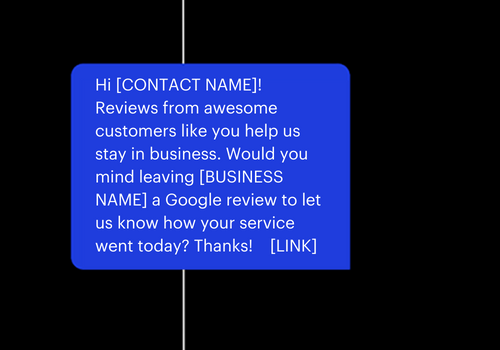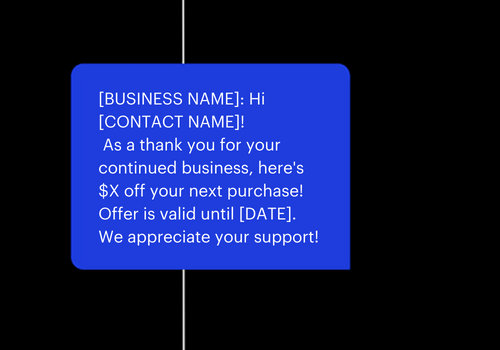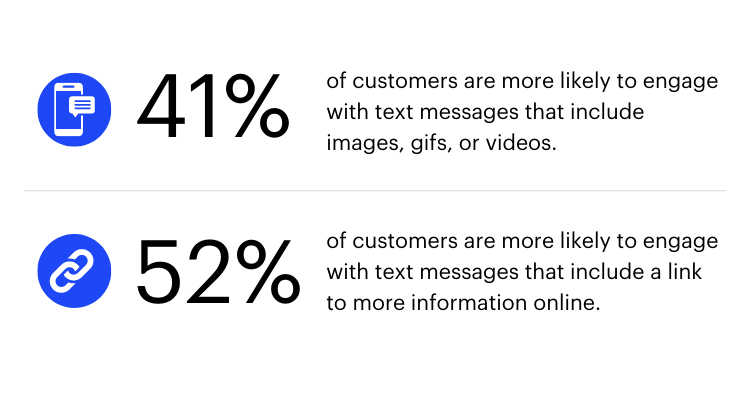The Modern Marketer’s Guide to Messaging
As you know, there’s a lot of noise in the marketplace. If you want to break through and grab the attention of today’s buyers, you’d better have something compelling to say.
It’s never been more difficult for marketers, especially those who work for local businesses, to compete.
And in addition to the increasingly fierce competition, you have a slew of communication channels to choose from. Which should you use to catch someone’s attention and establish a relationship with them? Enter: text message marketing.
Read on to learn how to use SMS messaging in a way that actually engages customers.
What’s the Deal with Business Text Messaging?
With up to a 98% open rate, and 3.8 billion smartphones in the world, mobile marketing has become an obvious front runner for local businesses—and, it’s the preferred channel of their customers.
Consider the following statistics:
- SMS messages have a 209% higher response rate than phone, email, or Facebook.
- 65.6% of consumers think texting makes working with a local business more convenient.
- Consumers are twice as likely (1.8x) to prefer text to any other communication method.
- 40.5% of consumers say they are likely to switch to a different business because that business offers text messaging to communicate.
Furthermore, consumers are 21% more likely to opt-in to local businesses’ text promotions over major chain or big-box retailers. And they’re 45% more likely to opt-in over online or eCommerce businesses.
Local businesses are also uniquely positioned to win with SMS messaging. According to our 2021 Local Business Messaging Trends report, local businesses are situated to reach their consumers’ text message inboxes more often than major chains and eCommerce players.
Basically, what we’re trying to say is: using text as a customer communication channel can lead to higher loyalty, more business, and more revenue.
How Businesses Can Use Text Messaging
Businesses can use text messaging for…everything. There. We said it. Review invites, surveys, campaigns, reminders, FAQs—the list goes on and on.
Reviews – With messaging, collecting a review is as simple as sending your customer a text with a link. And it’s ridiculously effective. After just 24 hours of using text for reviews, Paul’s Pest Control’s online rating jumped up half a star.

Sale or transaction – You can use text to transact by sending customers a click-to-pay link. This allows you to cut back on the wasted time and resources associated with gathering payments. No postage, no paper, no phone tag, no time at all. You’ll also see much higher response rates than with traditional methods, helping you and your team get paid faster.
Campaigns – SMS marketing is one of the most effective, personalizable ways to run a campaign as a local business. It’s also one of the most cost-effective. Compared to other digital campaigns, SMS campaigns are extremely low-cost to run, allowing you to engage new leads and increase customer lifetime value at very little cost.

Surveys – How do you get someone to actually take and respond to a survey? Text. By sending surveys via SMS, including possible incentives (think: fill out this survey to enter a giveaway), and explaining how the survey helps you better serve your customers, you significantly increase the chances of your customers responding.
Reminders – What’s that rule—never call or email if it could have been done with a text? Reminders are small—and that’s the key. They should be communicated in a minimalistic, convenient way, which means text is the perfect channel. By using automations to schedule recurring messages, you can make sure your customers never miss a reminder, which means less time wasted for everyone involved.

Website chat – Webchat tools make it easy to turn website browsers into buyers. With Podium’s Webchat, you can move website conversations to text, which means no more being chained to a computer or worrying about pages timing out. And the cherry on top? With Webchat, you can generate up to 11x more inbound leads from your website.
Referrals – Asking for referrals via text personalizes the conversation. When a real person asks for a referral, customers are more likely to give it. To sweeten the deal, offer your customers something in return, such as a sale or discount. And before you ask—yes, you could ask for a referral as a follow-up via email, but emails only have an open rate of 20%. As we’ve already mentioned, the open rate for text messages is much higher. That alone will increase your ability to get referrals.

Messaging Magic—How To Nail Business Messaging
When it comes to being effective, the straight shot is the best shot. Be straightforward with your customers. Address their pain points, use personalization to increase loyalty, show how your business, in particular, can help them achieve their goals, and demonstrate care.
Here are six best practices to get you started:
1 – Use conversational language. To appeal to your customers, keep personalized messages light-hearted, short, and conversational—just like you’re talking to a friend. And yes, you can include emojis to keep the conversation personal and informal! 👌😘😉
2 – Send during business hours. If your customer receives a message at 4:00 am, they won’t be happy—we’d recommend sticking to business hours. Keep in mind that sales and events promotions (especially website promotions) are most effective when they’re last-minute impulses. If you have an event on Wednesday night, consider sending the message as late as Wednesday afternoon.
3 – Respond in real-time. A seven-hour delay in response time doesn’t feel like a real conversation—it feels like a bot. 90% of customers rate an “immediate” response as important or very important when they have a customer service question. Try to respond as quickly as possible to avoid disengagement and increase connectivity.
4 – Don’t be subtle. Because you’re often trying to spur action quickly, you need to be straightforward about your intentions with a clear call to action (CTA) or pitch. For example, if you’re an orthodontist promoting Invisalign, you may explicitly encourage users to book a free consultation. To make a CTA even more enticing for potential customers, many direct marketers will offer a discount or other such promotion.
5 – Use multimedia. Put it all out there! Gifs, video, images, links, quizzes—the more interactive you make your marketing campaign, the more likely it is to engage your customers.

6 – Address the customer by name. If you’re running a campaign, you should address each customer by name and maybe even include relevant information about their past experiences with you. Even mass texts should sound like individual conversations. By tying your text software to your customer relationship management database, you can personalize messages effortlessly and make sure that each customer feels like you’re texting them and only them.
Conclusion
Business texting isn’t just the future—it’s here. It’s now. It’s time to hop on board. The local businesses that learn how to use text marketing will be well ahead of the competition for years to come.
And all of this starts with finding the right SMS marketing software.
Podium’s platform allows local businesses to collect reviews and feedback, take payments, chat with customers, send automated reminders and updates, and create and send effective campaigns all from one place. Get started here.
















